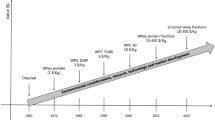Abstract
Soy protein isolate (SPI) contains 85–90% protein, and two major protein components 7S and 11S contribute to functional properties of protein. Acid precipitation is conventional method of soy protein isolates preparation that causes quality degradation. Ultrafiltration is a potential alternative to produce protein isolate to get high quality SPI with improved functional properties. The functional properties of SPI vary with processing variables. Nitrogen solubility index (NSI) is an important parameter to assess the functional quality. 11S/7S ratio affects the NSI value. 7S and 11S fraction of soy protein isolates ranged from 19 to 35% and 41 to 54%, respectively. SPI obtained from ultrafiltration process showed high 11S fraction and nitrogen solubility index. A “U” shaped graph was observed with 11S/7S verses nitrogen solubility index. The acid precipitated SPI with 11S/7S ratio of 1.82 occupies the bottom point with NSI value of 18.7. Ultrafiltered SPI (freeze and spray dried) with 11S/7S ratio 1.23 and 2.79, respectively had high NSI value occupying the top point of “U” shape graph.



Similar content being viewed by others
References
H. Wu, Z. Zhang, H. Huang, Z. Li, Health benefits of soy and soy phytochemicals. AME Med. J. 2, 162 (2017)
G. Rizzo, L. Baroni, Soy, soy foods and their role in vegetarian diets. Nutrients 10(1), 43 (2018)
FDA, USA, Code of Federal Regulations. Title 21. Food and drugs. Subchapter B—food for human consumption. Sec. 101.82. Health claims: Soy protein and risk of coronary heart disease (CHD), vol. 2 (2018)
W. Ma, B. Qi, R. Sami, L. Jiang, Y. Li, H. Wang, Conformational and functional properties of soybean proteins produced by extrusion-hydrolysis approach. Int. J. Anal. Chem. 2018, 1–11 (2018)
S. Liu, R. Zhou, S. Tian, J. Gai, A study on subunit groups of soybean protein extracts under SDS-PAGE. J. Am. Oil Chem. Soc. 84(9), 793–801 (2007)
V.R. Young, Soy protein in relation to human protein and amino acid nutrition. J. Am. Diet. Assoc. 91(7), 828–835 (1991)
L. Ning, R. Villota, Influence of 7S and 11S globulins on the extrusion performance of soy protein concentrates. J. Food Process. Preserv. 18(5), 421–436 (1994)
Y.L. Bian, D.J. Myers, K. Dias, M.A. Lihono, S.W. Wu, P.A. Murphy, Functional properties of soy protein fractions produced using a pilot plant-scale process. J. Am. Oil Chem. Soc. 80(6), 545–549 (2003)
C. Hu, L.H. Huang, W.Z. Li, Effects of 11S/7S ratios of soybean globulin protein on functionalities of soybean protein. J. Chin. Cereals Oils Assoc. 19(1), 40–42 (2004)
X.Z. Hu, Y.Q. Cheng, J.F. Fan, Z.H. Lu, K. Yamaki, L.T. Li, Effects of drying method on physicochemical and functional properties of soy protein isolates. J. Food Process. Preserv. 34(3), 520–540 (2010)
M. Joshi, B. Adhikari, P. Aldred, J.F. Panozz, S. Kasapis, Physicochemical and functional properties of lentil protein isolates prepared by different drying methods. Food Chem. 129(4), 1513–1522 (2011)
M.S. Hadnađev, T. Hadnađev-Dapčević, M.M. Pojić, B.M. Šarić, A.Č Mišan, P.T. Jovanov, M.B. Sakač, Progress in vegetable proteins isolation techniques: a review. Food Feed Res. 44(1), 11–21 (2017)
H.J. Kim, B.K. Kim, Comparison of soy protein concentrates produced using membrane ultrafiltration and acid precipitation. Food Sci. Biotechnol. 24(1), 67–73 (2015)
A.P. Gandhi, J. Srivastava, Studies on the production of protein isolates from defatted sesame seed (Sesamumindicum) flour and their nutritional profile. ASEAN Food J. 14(3), 175 (2007)
B. Karki, B.P. Lamsal, D. Grewell, A.L. Pometto, J. Van Leeuwen, S.K. Khanal, S. Jung, Functional properties of soy protein isolates produced from ultrasonicated defatted soy flakes. J. Am. Oil Chem. Soc. 86(10), 1021–1028 (2009)
B.U.K. Laemmli, Cleavage of structural proteins during assembly of head of bacteriophage-T4. Nature 227(5259), 680–685 (1970)
N.M. Saptarini, M.S. Wibowo, Ihsanawati, T. Gusdinar, Analysis of electropherogram profile of crude cartilage oligomeric matrix protein for rheumatoid arthritis diagnosis. J. Appl. Pharm. Sci. 7(12), 151–155 (2017)
D.R. Panthee, P. Kwanyuen, C.E. Sams, D.R. West, A.M. Saxton, V.R. Pantalone, Quantitative trait loci for b-conglycinin (7S) and glycinin (11S) fractions of soybean storage protein. J. Am. Oil Chem. Soc. 81, 1005–1012 (2004)
V.G. Ibarra, R. Sendón, A.R.B. de Quirós. Antimicrobial food packaging based on biodegradable materials. In Antimicrobial Food Packaging , ed. by J. Barros-Velázquez (Academic Press, New York, 2016), pp. 363–384
A.L. Bittencourt, I. Fernandes, I.R. Pereira, C.S. Honmoto, M.K. Tanaka, F.S. Lima, D.S. Abdalla, Detection of 7S and 11S soy protein fractions by monoclonal antibody-based immunoassays in food. Food Hydrocoll. 16(2), 91–100 (2005)
M.A. Aaron, L.W. Harold, Isolated soy protein, in New Protein Foods, Chapter 8, vol. 5, ed. by M.A. Aaron, L.W. Harold (Academic Press, New York, 1985), pp. 259–299
M.C. López de Ogara, M. Delgado de Layno, A.M. Pilosof, R.A. Macchi, Functional properties of soy protein isolates as affected by heat treatment during isoelectric precipitation. J. Am. Oil Chem. Soc. 69(2), 184–187 (1992)
Funding
There is no external funding source for this work.
Author information
Authors and Affiliations
Corresponding author
Ethics declarations
Conflict of interest
The authors declare that they have no conflict of interest.
Additional information
Publisher's Note
Springer Nature remains neutral with regard to jurisdictional claims in published maps and institutional affiliations.
Additional Information: General Structure of SAS Program used
Additional Information: General Structure of SAS Program used

Rights and permissions
About this article
Cite this article
John, H., Chandra, P., Giri, S.K. et al. Effect of Processing Methods on 11S/7S Protein and Nitrogen Solubility Index of Soy Protein Isolate. J. Inst. Eng. India Ser. A 102, 989–994 (2021). https://doi.org/10.1007/s40030-021-00564-7
Received:
Accepted:
Published:
Issue Date:
DOI: https://doi.org/10.1007/s40030-021-00564-7




